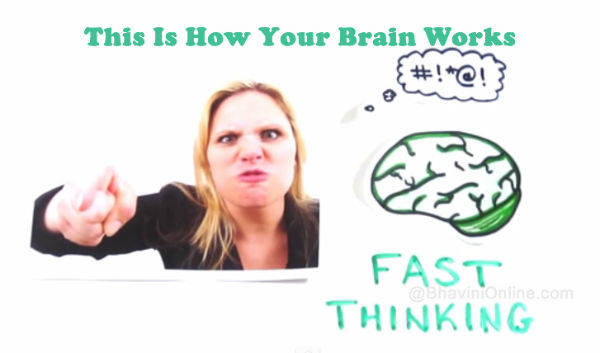Ever wonder how your brain processes information?
These brain tricks and illusions help to demonstrate the two main systems of Fast and Slow Thinking in your brain.
Brain Tricks – This Is How Your Brain Works
Transcript of the Video (Auto-generated):
0:00
You may not realize it but your brain actually processes information in two very
0:04
distinct ways. Like when you look at this photo you instantly know she has blonde
0:08
hair, is visibly angry and likely has some choice words to yell. Without any effort
0:12
you experienced fast thinking, But if you look at the following problem something
0:16
different happens. Sure you immediately know it’s a multiplication problem and you
0:20
knew you could solve it if you had the energy, but didn’t.
0:22
If you do try your muscles will tense, your pupils will dilate and your heart
0:26
rate will increase. Now you’ve experienced slow thinking.
0:29
These two systems of fast and slow thinking dictate much of our perception
0:33
and reaction in life.
0:34
Take these lines for example, it is clear that they’re different lengths, but if
0:38
you measure them they’re actually the exact same length. Even now that you
0:41
know, system one, or your fast thinking can’t stop seeing the illusion because it
0:45
acts automatically. A similar effect is seen here, which figure is the largest? Again
0:50
they are all the same size but the suggestion of perspective and depth
0:53
causes your system one to interpret the picture as three-dimensional even though
0:57
it’s on a flat two-dimensional surface.
0:59
It’s making quick work of the available information and so you’re conscious
1:07
to believe your intuition or instinct. Want to see your system two in action? I’ll show you a
1:11
string of four digits, you read them aloud and add one to each of the original
1:15
digits.
1:16
If the card reads 3795 the correct response would be 4806.
1:21
We’ll then go to the next card and you will do the same followed by the
1:25
next card.
1:25
ready? Go.
1:47
Few people can cope with more than four digits, but even harder is add three.
1:51
The interesting bit is that though your pupils would have dilated you often become
1:55
effectively blind when you fully engage system two.
1:58
Did you notice the colour of the text change?
2:00
Or how about the fact that the numbers completely changed when I put them off to
2:03
the side? Listen to the following puzzle. A bat and a ball cost one dollar and
2:07
ten cents. The bat cost one dollar more than the ball.
2:10
How much does the ball cost?
2:12
Chances are your system one intuition was yelling “ten cents”, but this appealing
2:16
system one answer we know is wrong. In fact the correct answer is five cents.
2:21
Even if you worked out the correct answer, you likely thought of ten cents along the
2:25
way. System one is trying to work out an answer as quickly and seamlessly as
2:29
possible which is extremely beneficial in everyday life. If every activity
2:33
required full mental effort it would be exhausting. But knowing this allows us to
2:38
understand that not all of our first impressions are correct.
2:41
How many animals of each kind did Moses take into the ark? So few people
2:45
detect what is wrong with this question and that it has been dubbed the the Moses
2:48
illusion.
2:50
In fact, moses took no animals, Noah did. Again our brain invests as little resources as
2:54
necessary so that things run quickly and smoothly. Because moses is not abnormal
2:59
in the biblical context, system one unconsciously detects an association
3:03
between Moses and arch, and quickly accepts the question.
3:06
In a similar way system one generates context without you knowing. Reading each
3:10
of the following may seem fairly simple “ABC” “Ann approached the bank” and “12, 13, 14”
3:15
3:16
But your brain actually interpreted these ambiguous statements without you ever
3:19
knowing. You could have read it as “A 13 C” or “12 B 14”,
3:25
but your brain created the context unconsciously. Also, you likely imagined a
3:29
woman with money on her mind walking towards a building with tellers, but if
3:32
the sentence before this was “they were floating gently down the river” the
3:36
entire scene would have changed because “bank” is no longer associated with “money”.
3:40
Without an explicit context, system one quickly generates one based on previous
3:44
experience. In this case, you have likely visited more banks then rivers and so
3:49
the context is resolved accordingly. This ties into a concept called “priming”.
3:53
For example if I said “wash”, how would you complete this word fragment? Most
3:57
would see “soap”, but had I just shown you the word “eat” you’d be more likely to
4:01
see “soup”.
4:02
I this way both eat and wash
4:04
prime your thoughts. Though system two likes to think that it’s in charge and knows
4:08
what’s going on, the truth is that priming effects have even been shown to
4:12
affect and modify behavior. These arise in system one and you have no conscious
4:17
access to them. If you’d like to learn more about the thinking systems in your
4:20
brain? Check out the book “Thinking Fast and Slow” by Daniel Kahneman which covers
4:24
it in great detail. I’ll put a link in the description which you can check out.
4:28
Got a burning question one answered? Ask it in the comments, or on facebook and twitter
4:32
And subscribe for more weekly science videos
Did you enjoy the video?
Do share your feedback in the comments section below.

